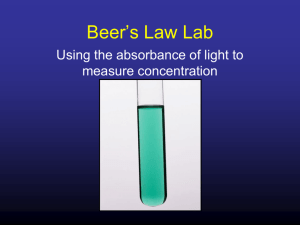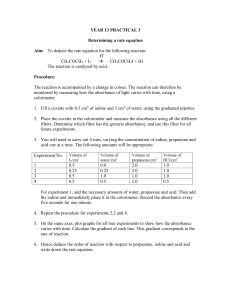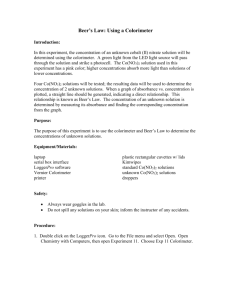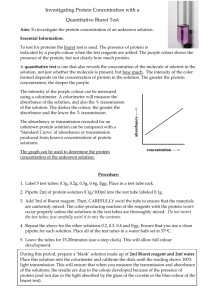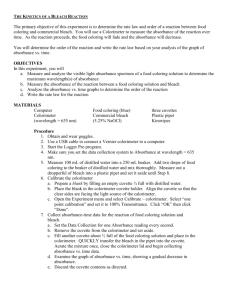Experiment 2 Kinetics II – Concentration-Time Relationships and Activation Energy
advertisement
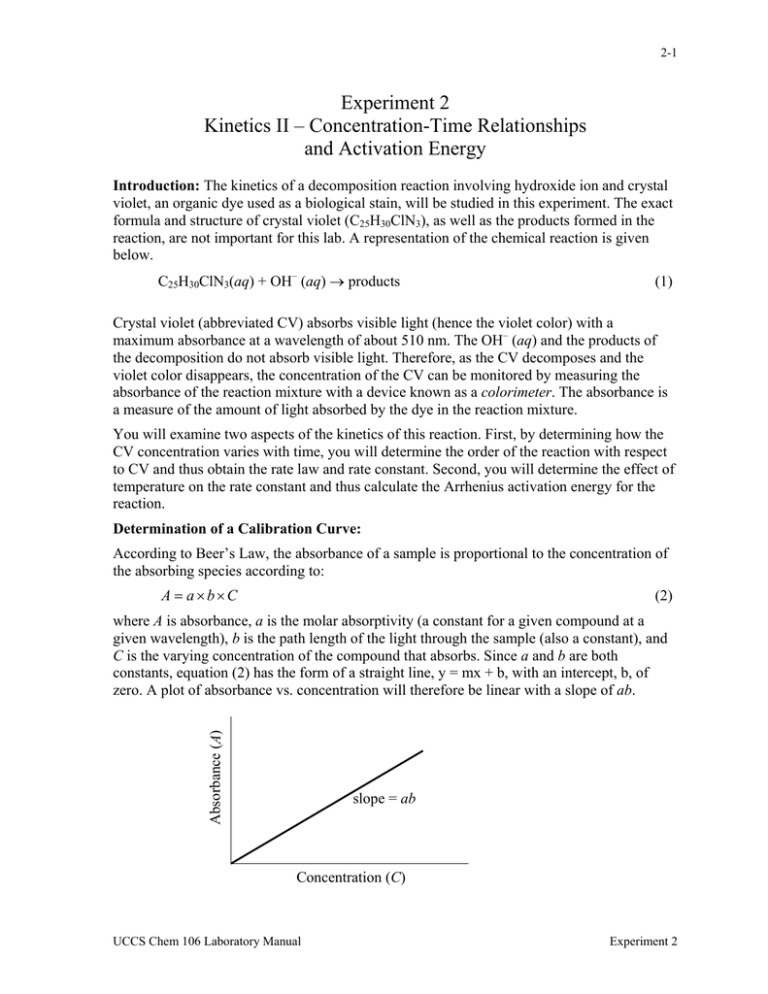
2-1 Experiment 2 Kinetics II – Concentration-Time Relationships and Activation Energy Introduction: The kinetics of a decomposition reaction involving hydroxide ion and crystal violet, an organic dye used as a biological stain, will be studied in this experiment. The exact formula and structure of crystal violet (C25H30ClN3), as well as the products formed in the reaction, are not important for this lab. A representation of the chemical reaction is given below. C25H30ClN3(aq) + OH– (aq) → products (1) Crystal violet (abbreviated CV) absorbs visible light (hence the violet color) with a maximum absorbance at a wavelength of about 510 nm. The OH– (aq) and the products of the decomposition do not absorb visible light. Therefore, as the CV decomposes and the violet color disappears, the concentration of the CV can be monitored by measuring the absorbance of the reaction mixture with a device known as a colorimeter. The absorbance is a measure of the amount of light absorbed by the dye in the reaction mixture. You will examine two aspects of the kinetics of this reaction. First, by determining how the CV concentration varies with time, you will determine the order of the reaction with respect to CV and thus obtain the rate law and rate constant. Second, you will determine the effect of temperature on the rate constant and thus calculate the Arrhenius activation energy for the reaction. Determination of a Calibration Curve: According to Beer’s Law, the absorbance of a sample is proportional to the concentration of the absorbing species according to: A = a×b×C (2) Absorbance (A) where A is absorbance, a is the molar absorptivity (a constant for a given compound at a given wavelength), b is the path length of the light through the sample (also a constant), and C is the varying concentration of the compound that absorbs. Since a and b are both constants, equation (2) has the form of a straight line, y = mx + b, with an intercept, b, of zero. A plot of absorbance vs. concentration will therefore be linear with a slope of ab. slope = ab Concentration (C) UCCS Chem 106 Laboratory Manual Experiment 2 2-2 By measuring the absorbance of solutions of CV with known concentration, a calibration curve can be prepared. Using the equation of the line for the calibration curve, any concentration of CV can be determined from the measured absorbance of the solution. The colorimeter actually measures how much light is transmitted through the sample. The transmittance is defined as the fraction of the incident light that passes through the sample and reaches the detector. In this experiment, the Vernier colorimeter will automatically convert the transmittance to absorbance (a dimensionless quantity). Determination of the Order of the Reactant CV: The rate expression for reaction (1) is: Rate = k[CV]m [OH - ] (3) where k is the rate constant of the reaction and m is the order of the reaction with respect to CV. It is known that the order of the reaction with respect to the OH− ion is 1. Analysis of the kinetics can be greatly simplified by keeping the hydroxide concentration much larger than the concentration of the crystal violet, [OH–] >> [CV]. When this is done, so little OH– is consumed compared to the initial high concentration of hydroxide, that [OH–] remains virtually constant throughout the course of the reaction. This allows for a modified expression for the rate law: Rate = k[OH - ][CV]m = k ′[CV]m with k′ = k[OH–] (4) The constant k′ is called a pseudo rate constant because it is a constant that relates the reaction rate to [CV]m , but only provided that [OH–] remains constant. Note that k′ would have a different value for a different [OH–]. In order to determine the value of m, you will measure the absorbance of the reaction mixture as a function of time. Once the absorbance (and hence [CV]) has been measured as a function of time, it is possible to determine the reaction order from the relationship between [CV] and time. For zero, first and second order reactions, there are different concentration-time relationships derived using calculus. The resulting equations are discussed in your textbook and class notes and are summarized in Table 1 (page 2-3). Therefore to determine the order, m, of the reactant CV from your [CV] vs. time data, you will create three plots, [CV] vs. time, ln[CV] vs. time, and 1/[CV] vs. time. The plot that gives a straight line for your data determines the reaction order as indicated in Table 1. Furthermore, the absolute value of the slope of the linear plot equals the pseudo rate constant, k′, which always has a positive value. (Note that measured slope is either positive or negative, and that the units of the slope differ, as indicated in Table 1). Also since the known order for [OH−] is n=1, from equation (4), we get k= k' [OH − ] UCCS Chem 106 Laboratory Manual (5) Experiment 2 2-3 which allows calculation of the rate constant, k, from the pseudo rate constant, k′, obtained as the slope and the known value of [OH−] for the reaction mixture. Order with respect to R Rate Expression and ConcentrationTime Relationship Graph Slope k′ units Zero, n = 0 [R]t = –k′t + [R]0 [R] vs. t – k′ M s-1 First, n = 1 ln[R]t = –k′t + ln[R]0 ln[R] vs. t – k′ s-1 Second, n = 2 1/[R]t = k′t + 1/[R]0 1/[R] vs. t k′ M-1 s-1 Table 1. A summary of concentration-time relationships for pseudo- zero, first and second order rate laws. [R] represents the concentration of the reactant, CV, in the rate law. Note that although the slope may be negative, k’ is always positive. Determination of the Energy of Activation for the Reaction: The value of the rate constant, k, is constant only for a single temperature. The values of k at different temperatures are related by the Arrhenius equation, k = A e - Ea / RT (6) −1 −1 where T is temperature in Kelvin; R is the universal gas constant, 8.3145 J mol K ; Ea is the activation energy of the reaction in J·mol−1; and A is a proportionality constant called the Arrhenius pre-factor (don’t confuse this with absorbance!). Taking the natural logarithm of both sides of equation (6) results in the following expressions: ⎛ − Ea ⎞ ln k = ln A + ⎜ ⎟ , which can be written as: ⎝ RT ⎠ ⎛E ln k = −⎜ a ⎝ R ⎞⎛ 1 ⎞ ⎟⎜ ⎟ + ln A ⎠⎝ T ⎠ (7) Since –(Ea/R) and ln A are constant, this has the form of a straight line. Thus a plot of lnk vs. 1/T will yield a slope equal to –(Ea/R), allowing calculation of Ea. However if data is collected at only two temperatures, T1 and T2, the activation energy can be found algebraically by writing equation (7) twice, substituting once with k1 and T1 and again with k2 and T2. Since the term, ln A, is constant, subtracting the two equations results in: ⎛k ⎞ ⎛E ln⎜⎜ 2 ⎟⎟ = −⎜ a ⎝ R ⎝ k1 ⎠ ⎞⎛ 1 1 ⎞ ⎟⎜⎜ − ⎟⎟ ⎠⎝ T2 T1 ⎠ UCCS Chem 106 Laboratory Manual (8) Experiment 2 2-4 Note that the two different reaction temperatures (which must be expressed in degrees Kelvin, K) will each have a different value of k. In this experiment the reaction will be done at room temperature and at ~1oC to find two different values of k′. Then equation (5) will be used to evaluate k at each temperature. Equation (8) will then be used to determine the activation energy of the reaction. Pre-Lab Notebook: Provide a title, purpose, reaction(s), summary of the procedure, and a table of reagents like the one below. Table of Physical Properties of Chemicals Used: Compound Formula Mass, FM (g/mol) Hazards Crystal violet Sodium hydroxide Create a Standard Solutions Table similar to the one in step 7 of Part A and fill in the values of CV concentration for every flask prior to the start of lab. Use the molarity, 2.5x10−5 M, and volumes of the CV stock solution in flasks B-F given in the Standard Solutions Table to calculate concentrations in the flasks after dilution to 50.0 mL with DI water. Note that the molarities of the standard solutions, B-F, will be given by [CV] = (2.5x10−5 M)(volume in L of CV stock solution)/0.0500L since each standard solution will have a total volume of 50.0mL. Equipment: 150 mL Beakers (2) 100 mL Beakers (3) 600 mL Beaker for waste 400 mL Beaker for CV stock solution Buret 100 mL Graduated cylinder 10 mL Graduated pipet Disposable pipets 50 mL Volumetric flasks (5) Ice-Water Bath Stopwatch Vernier LabPro Vernier Colorimeter and cuvettes Vernier Temperature Probe TI-84 Calculator Stock Solutions: 2.5 × 10–5 M Crystal Violet (0.020 g in 2.0 L) 0.40 M NaOH Experimental Procedure: Work in pairs. Before beginning, do Step C-2. Also note that due to possible discoloration of the cuvettes by the CV dye, the cuvette you use should be rinsed with 3M HCl and then DI water at the start of each of the following parts. Part A: Determination of the Calibration Curve: 1. Following the first section of the Vernier tutorial, set up the Vernier system in DATAMATE with the colorimeter connected to channel 1. Allow the colorimeter to warm up for at least 5 minutes while the standard solutions are prepared. UCCS Chem 106 Laboratory Manual Experiment 2 2-5 2. 3. 4. 5. 6. 7. Set the wavelength on the colorimeter to 565 nm (indicated by the green light) by pressing the < > arrows on the colorimeter controls. Label a 50 mL volumetric flask with one of the standard solution labels “A” through “F” as instructed by the Lab Instructor. Dispense the volume of the CV stock solution required (See table in step 7) to form the assigned standard solution directly from the buret containing the stock solution into your labeled volumetric flask. Carefully fill the flask to the 50.0 mL mark with de-ionized water. (Solution "A" in the Standard Solutions Table is the undiluted CV solution). Cover the flask with a small square of Parafilm and invert a few times to mix thoroughly. Use different Parafilm for each solution. Before proceeding, YOU MUST properly calibrate the colorimeter by filling the cuvette*** with DI water, inserting it in the colorimeter, and pushing the CAL button on the colorimeter. The red LEDs on the face of the colorimeter will flash several times and the absorbance will read 0 or .001. Record this value in the Absorbance column for the DI H2O. If you do not get a value near zero, press CLEAR and try again. *** Note: the plastic cuvettes have one set of opposite sides with ridges designed for holding the cuvette, and a clear set of sides through which the light to be absorbed passes. These clear sides must line up with the arrow inside the colorimeter. Always put the cuvette in the colorimeter in the correct orientation. After calibration, remove and empty the cuvette. Using your assigned standard solution, rinse the cuvette once and then fill the cuvette three-fourths full. (Tip: It is easier to transfer solution into the cuvette using a disposable pipet than pouring directly from a volumetric flask.) Wipe the outside clear sides of the cuvette with a tissue wipe. Place the cuvette inside the colorimeter (clear sides lined to arrow!) and close the lid. Allow 15 seconds to pass for the colorimeter to take an accurate reading. When the absorbance reading stabilizes, record the reading in your Standard Solutions Table and in the table your Instructor has drawn on the blackboard. Complete the Standard Solutions Table below by calculating all the CV concentrations and entering the Absorbance values recorded by other teams: Flask Volume of Stock CV (mL) Concentration of CV (M) Absorbance A 50.0 0.000025 B 40.0 C 30.0 D 20.0 E 10.0 F 5.0 DI H2O 0.0 0.0 Part B: Determination of Order of the Reactant CV: (Kinetic Run – Room Temperature) 1. Set up the Vernier system with the colorimeter connected to channel 1 and the temperature probe connected to channel 2. 2. Set the data collection mode on the LabPro: On the main screen of the datamate program, go to setup and move the cursor until it’s to the left of the mode selection and press enter. Select “2” for time graph mode. Select change time settings. Type “5” for UCCS Chem 106 Laboratory Manual Experiment 2 2-6 3. the time between samples in seconds, and press enter. Type “100” for the number of samples, and press enter. Therefore for this run, data will be collected every 5 seconds for a total of 500 seconds. Select OK twice to return to the main screen. Using the buret, transfer 20.0 mL of CV stock solution into a 150 mL beaker. Place the temperature probe into this solution and leave it there for the entire run. Using a 10 mL graduated pipet, transfer 5.0 mL of 0.40 M NaOH into a 50 mL beaker. The reaction will not begin until the solutions in the two beakers are mixed. Add the NaOH to the CV solution and immediately press 2 for START on the calculator. Swirl the beaker for a 5-10 seconds after mixing to mix well. Rinse and fill the cuvette ¾ full with the mixed solution, wipe the clear sides, and place the cuvette into the colorimeter. Once the LabPro beeps, the run is complete, press STO>. In your notebook, note the shape of the plotted data and then hit ENTER to get out of the graph. Select “6” for QUIT from the main screen. Then press ENTER on the screen that indicates your data location. Transfer this data (from L1, L2, and L3) to the Logger Pro computer program. Cut and paste the columns of data (starting with the first high value for absorbance!) into Microsoft Excel. Label and save the Excel file for later analysis in the post-lab section. 4. 5. 6. Part C: Determination of the Energy of Activation for the Reaction: (Kinetic Run ~1°C) 1. 2. Set up the data collection mode in the DATAMATE program to EVENTS WITH ENTRY mode. Since the temperature must be constant and close to 1oC, the reaction mixture is left in the ice-water bath. Using a disposable pipet, samples will be extracted from the reaction mixture (while it remains in the ice bath) and placed in the cuvette for absorbance measurements at times measured using a stopwatch. Each absorbance measurement is an EVENT with the stopwatch time will be recorded as an ENTRY. Transfer 60 mL of CV stock solution using a 100 mL graduated cylinder into a 150 mL beaker. Using the graduated pipet, transfer 15.0 mL of 0.40 M NaOH into a separate 50 mL beaker. Place both beakers into an ice-water bath in a clear plastic container. Be careful that the water level in the ice-bath is not so high as to cause the beakers to turn over in the bath or water from the bath to seep into the beakers. To avoid confusion during this experiment, read and understand steps 3-7 before proceeding! Also make sure you know how to use the stopwatch. 3. 4. 5. Place the temperature probe into the CV stock solution and keep it there during the run. Swirl the beakers gently for about 5 minutes or until the temperature probe reads close to 1oC in each solution. Wipe the probe before switching from one solution to the other. Press 2 for start on the calculator. Quickly, but carefully, add the NaOH solution to the CV solution and immediately start the stopwatch. . Caution: Do not stop the stopwatch until Step 8 is completed! Swirl the beaker for 5-10 seconds after mixing and immediately proceed to the next step. With the reaction mixture beaker remaining in the ice bath (where it must remain during the entire run), use a disposable pipet to draw out enough of the reaction mixture to quickly, but carefully, fill the cuvette ¾ full and place it in the colorimeter. UCCS Chem 106 Laboratory Manual Experiment 2 2-7 6. When the absorbance reading stops increasing (in about 10-15 seconds), press ENTER to get the absorbance reading and immediately note the time you pressed ENTER on the stopwatch. Record both the absorbance and the time you pressed ENTER in a table in your lab notebook. When prompted by the calculator with “ENTER VALUE,” enter your recorded time for the reading in seconds (for example, 2min:15sec = 135 seconds). It is important to input the correct time at which ENTER was pressed to measure absorbance. Then remove and empty the cuvette into a waste beaker. 7. To get the next data point, refill the cuvette from the reaction mixture in the ice bath using the disposable pipet to get the next time / absorbance readings. 8. Repeat Steps 6 and 7 and continue to record data both on the LabPro and in your lab notebook approximately every minute for a total of ten minutes. After the last data point is collected, press STO>. Press ENTER to exit the graph and get to the main screen. 9. Select “6” for QUIT from the main screen. Then press ENTER on the screen that indicates your data location (L1, L2 and L3). 10. Transfer this data (from L1, L2, and L3) to the Logger Pro computer program, cut and paste the columns of data into a Microsoft Excel file. Save the file for later analysis in the post-lab section. Alternatively, you may simply directly transfer your data from your lab notebook into an Excel file. UCCS Chem 106 Laboratory Manual Experiment 2 2-8 Lab Report Outline for Kinetics II Graded Sections of Report Percent of Grade Pre-Lab 10 In-Lab 10 Post-Lab Report (You will save considerable time and effort by using Excel to carry out your calculations and plotting. But in your report’s post-lab section, show required calculations as indicated below, being sure to number each step.) Part A: Calibration Curve: 1. Show a sample calculation of [CV] for standard solution C. 3 2. Attach an Excel spreadsheet giving the Step A-7 table of data and a clearly labeled Beers Law plot showing the equation of the line and a trend line. 10 Part B: Kinetic run – room temperature: 1. Show a sample calculation of [CV] from the first high absorbance value recorded in your Excel file using the trendline equation from the calibration curve. 3 2. In Excel, using the equation of the line from the calibration curve, convert each of the absorbance values into [CV]. (Hint: with Excel, you only need to apply a formula to the first cell and copy it to the remaining rows). Attach an Excel table with values of [CV], ln[CV], and 1/[CV] with times for 300 seconds of the run (starting with the highest Absorbance). 5 3. Find the reaction order, m, by plotting the following (use only the 300 seconds of data): 1: Concentration vs. time (If linear, reaction is zero order, m = 0) 2: ln(concentration) vs. time (If linear, reaction is first order, m = 1) 3: 1/(concentration) vs. time (If linear, reaction is second order, m = 2) Attach the plots to the report (with a trend line through the linear plot only) and state in the post-lab section: “The plot that is linear corresponds to m = ____” 15 4. State “From the slope of the linear plot, k’ = ________ at ______oC” 5 5. Show the calculation of [OH−] in the reaction mixture (= mol OH− /L reaction mixture). The moles of OH− in the reaction mixture equals (M×V) of the NaOH stock solution added. 3 Volume in L of reaction mixture is the sum of the CV and OH− stock solution volumes. 6. Using Eqn (5), calculate k from k’ and [OH−] and state its value.______(correct units)_ 5 Part C: Energy of Activation: 1. Use the same equation that gave a linear plot in Step B-3, plot the data from the run at ~1oC. Attach this chart (with trendline and equation) to your report. o 2. State “From the slope of the linear plot, k’ = _______(correct units) at ___ C.” 5 − 3. As in step B-5, show the calculation of [OH ] used for this run. o 8 3 − 4. Using equation (5), calculate k at ~1 C from k’ and [OH ]. State its value.___(units). 5 5. From the 2 sets of k and T values, calculate Ea using Eqn (8). (Use T in degrees K!) 10 UCCS Chem 106 Laboratory Manual Experiment 2

